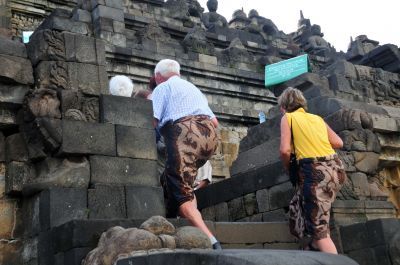Indonesia asks Borobudur visitors to don a sarong

Visitors flashing their knees at Indonesia's number-one tourist attraction, the ancient Borobudur temple, will have to wear government-issue sarongs under a new plan to protect the site's dignity.
Officials said tourists wearing shorts and mini-skirts would be politely asked to don a sarong for the duration of their visit to the Buddhist temple, erected between 750 and 850 on a verdant plain in central Java.
"When visitors enter a sacred place, they must show their respect. They shouldn't wear shorts or mini-skirts because it's impolite," temple manager Purnomo Siswo Prasetyo told AFP on Wednesday.
"It's like in Bali - when tourists visit temples there, they also have to do the same thing," he said, adding that the rules were put in place after locals and visitors complained about the attire of some tourists.
During a month-long trial, tourists will also be required to wear rubber sandals to avoid damaging the temple's intricately carved stonework, he said.
The optimal footwear to ensure as little damage as possible is done to the temple's volcanic stones is made of woven dried pandanus leaves, he said.
Such items were not yet available but they had been ordered from the local community and could soon be added to the list of things inappropriately attired tourists will have to wear.
No fee would be charged for use of the sarongs and sandals during the trial, but Prasetyo said he could not rule out a charge at a later date.
"We hope this will open up job opportunities for surrounding communities and lead to economic growth," he said.
Some 2.5 million tourists visited Borobudur last year. Indonesians pay 15,000 rupiah (1.60 dollars) to enter the compound while foreigners are charged 15 dollars.
As Islam spread through Java after the 12th century, the "temple mountain" of Borobudur was abandoned and lost to the jungle.
It was "rediscovered" in 1814 by English colonial trader Sir Thomas Stamford Raffles and was restored with the help of UNESCO in the 1970s.
Join our commenting forum
Join thought-provoking conversations, follow other Independent readers and see their replies
Comments
Bookmark popover
Removed from bookmarks